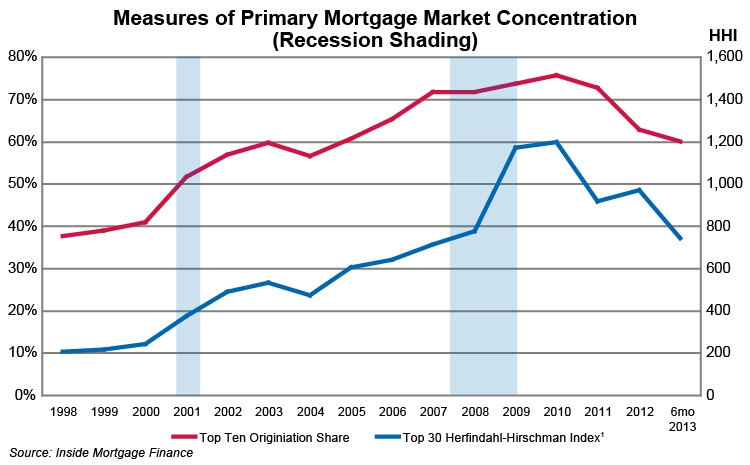Deconsolidation in the Primary Mortgage Market: A Temporary or Structural Trend?

For many years, concentration in the U.S. primary mortgage market – as measured by top originators’ share of mortgage originations – grew at a largely uninterrupted pace. In the wake of the crisis, however, the level of concentration in the primary market has declined more than 20 percent (see chart below). One reason for this decline was the withdrawal of large lenders, with only 5 of the top 20 single-family mortgage originators in 2006 remaining active in the market today.

In the most recent edition of Housing Insights, we investigate whether or not the recent decline in top lender share of market origination is more likely a function of cyclical or structural market factors.
Large and small lenders enjoy advantages over each other in the mortgage marketplace. However, we believe large lenders benefit from more significant and potentially more sustainable advantages relative to small lenders. Consequently, our assessment indicates that the recent decline in large lender share of the primary market is temporary, and principally a result of cyclical factors that caused larger lenders to pull back from the market. Absent a meaningful restructuring of the mortgage market (our analysis did not contemplate changes that may come from reform of the housing finance system, as we do not yet know the timing and shape of reform), we believe there is a significant probability that in the long-term large lender share of the primary market will increase compared to current levels.
Related Links
Housing Insights: Deconsolidation in the Primary Mortgage Market: A Temporary or Structural Trend?
FM Commentary by Renee Schultz: Providing Liquidity to the Market
FM Commentary by John Nichols: Understanding Fannie Mae Delivery Limits
Gerry Flood
Director, Strategic Planning
Economic & Strategic Research
The author thanks Orawin Velz, Pat Simmons, Tom Seidenstein, Mark Palim, Doug Duncan, Pete Bakel, Noel Fahey, Michael Vangeloff, and Paul Mahler for valuable comments in the creation of this analysis. Of course, all errors and omissions remain the responsibility of the authors.
Opinions, analyses, estimates, forecasts and other views of Fannie Mae’s Economic & Strategic Research (ESR) Group included in these materials should not be construed as indicating Fannie Mae’s business prospects or expected results, are based on a number of assumptions, and are subject to change without notice. How this information affects Fannie Mae will depend on many factors. Although the ESR Group bases its opinions, analyses, estimates, forecasts and other views on information it considers reliable, it does not guarantee that the information provided in these materials is accurate, current or suitable for any particular purpose. Changes in the assumptions or the information underlying these views could produce materially different results. The analyses, opinions, estimates, forecasts and other views published by the ESR Group represent the views of that group as of the date indicated and do not necessarily represent the views of Fannie Mae or its management.
The views expressed in these articles reflect the personal views of the authors, and do not necessarily reflect the views or policies of any other person, including Fannie Mae or its Conservator. Any figures or estimates included in an article are solely the responsibility of the author.
